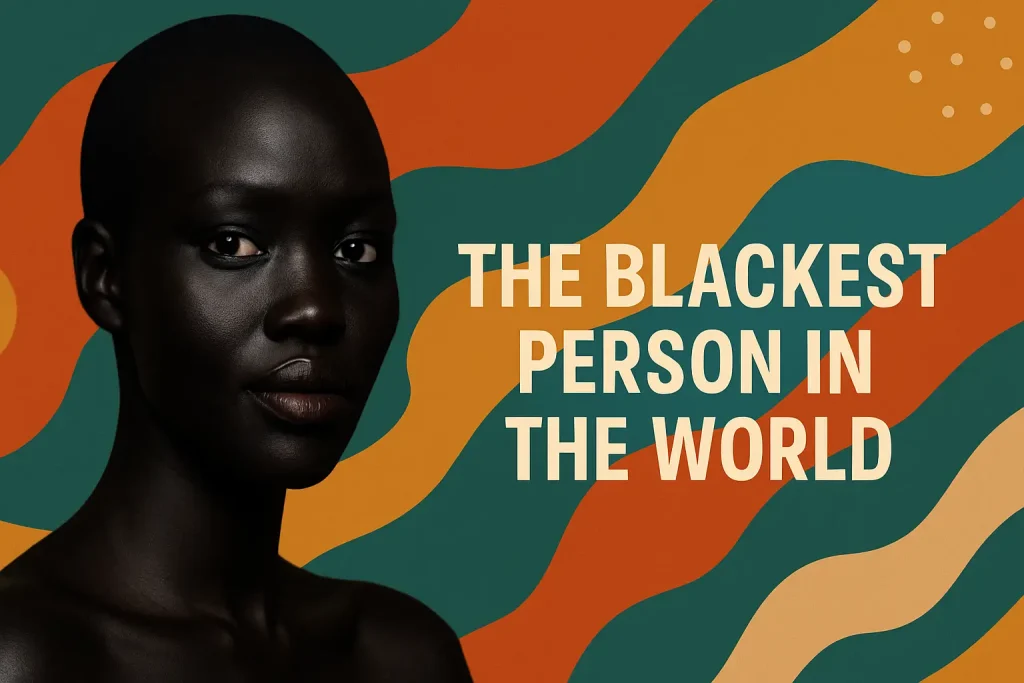
Beauty is not one shade, and the world is awakening to that truth. In recent years, society has begun to recognize and celebrate the deepest tones of human skin—a victory for diversity, representation, and humanity itself. At the heart of this celebration is a woman whose stunning complexion has sparked global admiration: Nyakim Gatwech. Commonly known as the “Queen of Dark,” Nyakim’s skin tone is more than a color—it’s a statement of pride, heritage, and empowerment.
Across cultures and continents, melanin-rich individuals have been historically marginalized. But today, through education, awareness, and figures like Nyakim, the tide is shifting. This article takes a deep, expert-informed look at human skin pigmentation, colorism, and how one South Sudanese model is changing the conversation around beauty and identity.
Who Is the Blackest Person in the World? A Closer Look
When it comes to the darkest skin tone ever recorded, many people look to Nyakim Gatwech, a South Sudanese-American fashion model celebrated for her radiant, ultra-dark skin. Though there is no official scientific ranking of skin tones, Nyakim’s complexion is widely regarded as one of the deepest naturally occurring on record. With melanin levels that provide unmatched pigmentation, her appearance challenges long-standing beauty standards.
Nyakim’s global recognition stems not just from her skin tone but from her confidence, activism, and defiance against colorism in society. Through interviews, fashion campaigns, and Instagram posts, she has become a symbol of dark skin pride and representation in fashion. More than a model, Nyakim is a movement—a voice that dares to say that the darkest skin is just as worthy of admiration as any other.
Also Read: https://gossipsmag.co.uk/benzino-net-worth/
Nyakim Gatwech: The Queen of Dark and a Global Beauty Icon
Nyakim Gatwech’s journey began in Ethiopia, born to South Sudanese parents who fled conflict. After moving to the United States, she was exposed to Western beauty standards that often favored lighter complexions. Rather than conform, she embraced her unique look, and the fashion industry took notice. Her stunning features and deep pigmentation turned heads on runways and magazine covers alike.
Nicknamed the “Queen of Dark,” Nyakim uses her fame to empower other melanin-rich individuals. She often speaks about racial identity and appearance, drawing attention to colorism and challenging the notion that fairer skin is more desirable. Her authenticity, amplified by her Instagram following, has made her an icon not just of fashion, but of self-love and resistance against societal bias.
What Determines Skin Color? The Science of Melanin Explained
Melanin is the key pigment responsible for skin color. Produced by cells called melanocytes in the epidermis, melanin also plays a role in eye and hair color.
- Eumelanin: Produces black and brown pigments and is the dominant form in individuals with dark skin.
- Pheomelanin: Produces red and yellow pigments, often present in lighter skin tones.
- Genetics of skin color: Controlled by multiple genes including MC1R, SLC24A5, and OCA2.
- UV radiation adaptation: Darker skin provides protection against sun damage and folate degradation.
Human skin pigmentation is influenced by ancestry and geography, particularly proximity to the equator, where UV radiation is more intense. Over generations, populations living in high UV regions evolved higher melanin levels, offering natural protection.
Melanin Mastery: Why Some People Have Exceptionally Dark Skin
Some individuals, like Nyakim, naturally produce more eumelanin due to inherited genetic variations. This results in deep skin pigmentation that ranges from rich brown to deep blue-black. These genetic traits often originate from equatorial ancestry—regions like South Sudan, Nigeria, and Ethiopia.
Such pigmentation is not a rarity but part of the vast skin tone spectrum present within the African diaspora. These skin tones reflect powerful evolutionary advantages and are stunning examples of natural human variation. High melanin levels also contribute to skin resilience, reducing signs of aging and offering UV protection.
Dark Skin in Human Evolution: A Protective Superpower
Dark skin is not just beautiful—it’s biologically brilliant. In human evolution, skin tone adapted to environmental factors, particularly UV radiation. Melanin-rich skin evolved as a protective mechanism in sun-intensive regions, helping to prevent folate deficiency, which is vital for reproduction.
This evolutionary advantage helped early humans thrive in Africa. The pigmentation acted like a natural sunscreen, protecting the skin’s DNA from damage and maintaining reproductive health. Today, that legacy remains visible in millions of people with dark skin, a true testament to the power of biology and adaptation.
The Role of Genetics and Geography in Deep Skin Pigmentation
Genetics and geography play a powerful role in determining skin tone. People from equatorial regions typically inherit genes that promote higher melanin production. Over generations, this leads to deeply pigmented skin tones, often seen in communities from South Sudan and other parts of sub-Saharan Africa.
Key genes like SLC24A5 and SLC45A2 have been linked to variations in skin pigmentation. Research by the WHO and other scientific institutions confirms that these genes interact with environmental exposure, like UV radiation, to shape the diversity in skin tone we see today.
Colorism vs. Racism: Understanding the Social Struggles of Dark-Skinned Individuals
Colorism, unlike racism, occurs within the same ethnic group, where lighter skin is often preferred. This bias has been perpetuated by colonialism, media portrayals, and global beauty standards. People with the darkest skin often face discrimination not only from other races but within their own communities.
Nyakim Gatwech has been vocal about experiencing colorism—from microaggressions to overt prejudice. Her mission is to raise awareness about how harmful these internal hierarchies can be. She promotes acceptance, encouraging others to embrace their heritage and challenge ingrained societal norms.
The Dark Skin Bias in Fashion and Media: Breaking the Mold
Historically, the fashion industry has favored lighter skin tones, often sidelining darker-skinned models. Nyakim’s rise disrupts this trend. Her success is reshaping representation in fashion and expanding what is considered “beautiful.”
More brands are now embracing diverse models, recognizing that skin tone diversity resonates with global audiences. This shift is about more than inclusion—it’s about authenticity. Nyakim’s presence is a wake-up call to an industry that once feared deep pigmentation.
Empowering Representation: How Nyakim Gatwech Changed Beauty Norms
With her radiant complexion and fearless attitude, Nyakim is a beacon for dark skin pride. She redefines natural beauty standards and encourages young girls to love their skin. Her Instagram platform showcases not only fashion but resilience and pride.
Nyakim’s impact is profound. From billboards to brand campaigns, she proves that the darkest skin is not a barrier—it’s a badge of honor. Her message is clear: beauty knows no shade.
From South Sudan to the Spotlight: African Roots of Deep Pigmentation
South Sudan, Nyakim’s ancestral homeland, is one of many African regions where deep skin pigmentation is common. The climate and genetic lineage of these regions favor high melanin levels, contributing to the striking skin tones seen among many tribes.
These communities hold cultural pride in their appearance. Unlike in the West, where darker skin can be stigmatized, in many African cultures, it symbolizes strength, beauty, and heritage. Nyakim’s story is deeply rooted in this legacy.
Melanin in Numbers: Is There a Scientific Scale for Skin Darkness?
Scientists use methods like reflectance spectrophotometry to measure skin pigmentation.
- Melanin Index: Measures melanin concentration in the epidermis.
- Fitzpatrick Skin Type Scale: Ranges from Type I (very fair) to Type VI (very dark).
- Reflectance Value: Lower reflectance = darker skin.
- WHO Studies: Identify trends in pigmentation across populations.
While there’s no “official” blackest person, Nyakim Gatwech is often cited due to her visibility, confidence, and stunning natural pigmentation.
Historical Views of Dark Skin: From Ancient Africa to the Modern World
In ancient Africa, deep skin was celebrated. Kings, queens, and warriors often bore the richest skin tones. Egyptian art, for example, depicts Nubian royalty with jet-black skin—a sign of nobility and divine favor.
Colonialism and slavery disrupted these narratives, introducing colorism and white supremacy ideals. But today, the pendulum is swinging back, with dark skin reclaiming its rightful place in cultural pride.
Health Implications of High Melanin Levels: Myths and Facts
One myth is that darker skin doesn’t need sun protection. While melanin offers UV protection, it’s not immune to sun damage or cancer. Sunscreen remains essential.
On the positive side, high melanin levels reduce the appearance of wrinkles and offer better resistance to certain skin conditions. Melanin-rich individuals often enjoy a youthful complexion well into old age.
Social Media and Skin Pride: The Rise of the #MelaninMovement
Platforms like Instagram have been crucial in amplifying melanin-rich voices. Hashtags like #MelaninQueen and #DarkSkinMagic promote inclusivity and confidence.
Nyakim’s influence on social media cannot be overstated. Her feed is filled with empowering messages, artistic fashion, and proud representation of African beauty.
How Lighting and Photography Affect Perception of Skin Tone
Lighting can distort how skin appears in photos. Poor lighting often washes out darker skin or alters its rich undertones.
Professional photography that respects melanin enhances its depth and glow. This has led to increased demand for inclusive lighting techniques in media.
Celebrating the Beauty of All Shades: Ending Skin Hierarchies
Beauty exists on a spectrum, and every shade deserves celebration. Ending colorism means challenging skin hierarchies and uplifting all tones.
Campaigns promoting skin tone diversity are on the rise. From commercials to classroom conversations, the world is embracing a fuller picture of beauty.
Dark Skin and Identity: More Than Just Appearance
- Cultural Legacy: Dark skin often reflects ancestral roots and traditions.
- Personal Confidence: Embracing skin tone enhances self-worth.
- Social Identity: Skin color can influence societal perception.
- Psychological Impact: Acceptance leads to better mental health.
Nyakim proves that identity isn’t about assimilation—it’s about authenticity.
Are There Others Like Nyakim? Profiles of Individuals with Deep Pigmentation
While Nyakim is prominent, many others share similar skin richness. Tribes like the Dinka and Nuer of South Sudan exhibit profound melanin levels. These individuals are often celebrated within their cultures for their striking looks.
Social platforms have helped discover others with similar pigmentation, though not all seek fame. Many use their platforms to inspire pride and challenge stereotypes.
The Spectrum of Human Skin: From Albinism to Hyperpigmentation
Skin tone is incredibly diverse, ranging from albinism (lack of melanin) to hyperpigmentation (excess melanin). This diversity is what makes humanity beautiful.
Albinism and deep pigmentation highlight the extremes of human biology. Both require understanding and respect, rather than judgment or ridicule.
FAQs
Q: Who has the darkest skin in the world?
A: Nyakim Gatwech is often cited due to her visibility and deep pigmentation, though there’s no official scientific title.
Q: What causes dark skin?
A: High melanin production, influenced by genetics and geography.
Q: Is dark skin healthier?
A: It offers UV protection and ages more slowly but still needs care and sun protection.
Q: What is colorism?
A: Discrimination based on skin tone, often favoring lighter complexions.
Final Thoughts
Nyakim Gatwech isn’t just the “blackest person in the world”—she is a symbol of beauty, pride, and strength. Her story is reshaping how we see skin, race, and representation. Through science, culture, and celebration, we can honor every shade of humanity. The era of skin pride is here—and it’s radiant, resilient, and deeply inspiring.






